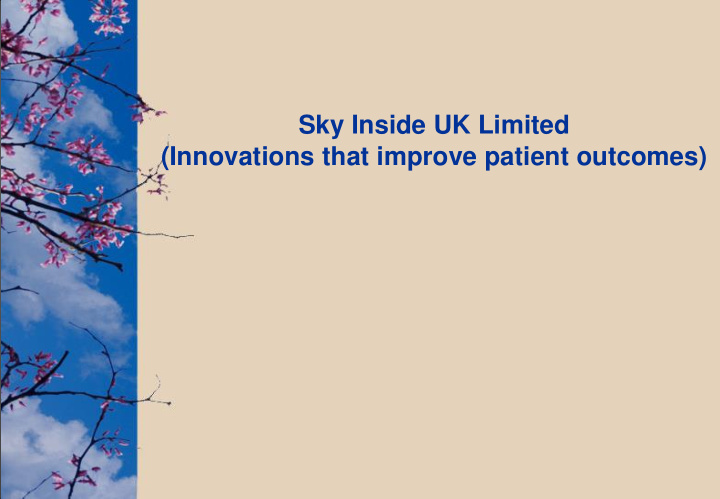



Sky Inside UK Limited (Innovations that improve patient outcomes)
Research into Melatonin stimuli, pain suppression and interactivity of the Pineal gland within the Hypothalamus • For over 25 years a number of research studies into the clinical environment have been carried out looking at the use of Art, Interior design and the patient journey to improve the experience whilst aiding the recovery process. • A study carried out by Dr. Phil Leather of Nottingham University in February 2000 looked at the following areas: • Basic appraisal of patient, consulting and waiting areas. • Outpatients waiting areas. (cardiac) • Coronary Angiography day case. • Cardiology and Cardiothoracic ward study. • A general staff study. • The general conclusions of the study found that by utilizing scenes and images of nature with an appropriate “daylight level” the patients in , for example post surgery, were recovering 27% quicker whilst requiring less pain medication at a similar level
The pineal gland The pineal gland is a small pine cone like shape structure located deep between the cerebral hemispheres, where it is attached to the upper part of the thalamus near the roof of the third ventricle. The normal pineal gland appears as a small reddish-brown structure and the normal size ranges between 10 and 14 mm. Two primary cell types make up the pineal gland. The pineocyte is the principal parenchyma cell and comprises 95 % of the pineal gland. The other 5 % are supporting cells referred to as astrocytes. Together, these two cell types are arranged in lobules, which are separated by a fibrovascular stroma. Calcifications commonly occur within the pineal gland and are often associated with increasing age.
Visual pathway Visual cortex Suprachiasmatic nucleus Nonvisual pathway Optic nerve
Visual Suprachiasmatic cortex nucleus Circadian Vision adjustment to light Signal to brain Rods and cones Photosenstive RGC Pigments Melanopsin (photopigment) Light
• How does it work • The 3 rd receptor (ipRGC) in the eye looks for the blue portion phase of the natural light. • They send light information via the retinohypothalmic tract directly to the circadian pacemaker of the brain, the suprachiasmatic nucleus of the hypothalamus. • The physiological properties of these ganglion cells match known properties of the daily light entrainment (synchronization) mechanism regulating circadian rhythms . • They contribute to photic regulation of, and acute photic suppression of, release of the hormone Melatonin from the pineal gland • In circadian lighting terms, the ‘superstar’ wavelength is in the blue spectrum – about 480nm, the peak sensitivity of ipRGCs
S k y I n s i d e U K L i m i t e d ™ Walton Centre Press release ITU first to use innovative ‘Sky Inside UK’ to help treat patients with delirium. The New Sky Viewing System for trauma patients. The Walton Centre’s Intensive Therapy Unit (ITU) has installed cutting -edge technology which allows patients to visualise the sky to help minimise delirium. The ‘Sky Duo Ceiling System’ streams high -quality footage of the day and night sky to help improve patient sleep patterns and thereby reducing the incidence of delirium, a phenomenon that intensive care patients are at higher risk of. Last year staff set up a delirium prevention group and circulated education and sleep hygiene information, a key part of delirium prevention. The system was funded by charitable donations from patients and visitors of the ITU fund. Dr Sandeep Lakhani, Clinical Director of Neuroanaesthesia and Critical Care, said “The patients we see coming in can have extensive traumatic head injury. Delirium can be an added complication which hampers rehabilitation. “The staff on ITU have embraced the prevention measures and the new sky system. 8
The Walton Centre is committed to providing high-quality care for every patient and it’s exciting to be able to look at new innovation to deliver it.” Consultant Anaesthetist Dr Priya Nair was key in bringing the system to the Trust. She said: “We’re really proud that we’ve been able to provide this for one of our patient rooms in ITU. This new system is the only one I’m aware of in the country. “Intervening and preventing delirium has substantial implications when it comes to improving outcome and the patient’s quality of life post intensive care. We’ve got more ideas on combating this – the ceiling is just the beginning.
Recommend
More recommend